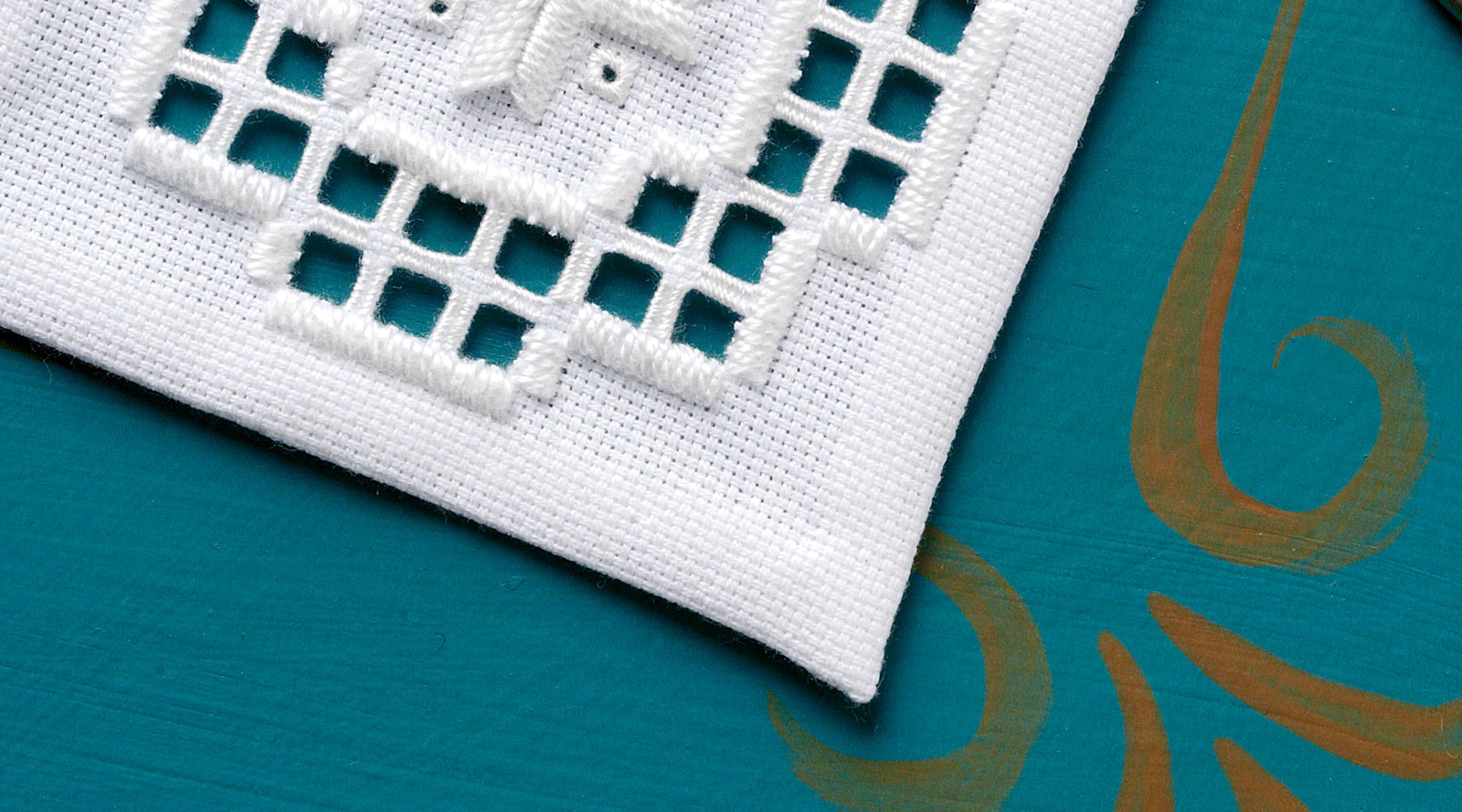It amazes me what those pioneer Norwegian women were able to accomplish given all the work they had to do just to get food on the table, clothes on their backs, and provisions put up against the long, hard winters.
When Laurann Gilbertson, Vesterheim’s chief curator, asked if I would create a modern piece based upon a tablecloth in the collection, I jumped at the chance. I wanted to create something for a table setting, and both the shape and the size of the cloth’s strong, square design element suggested a coaster.

Detail of Joan Leuenberger’s Hardanger coaster
Materials
Zweigart Hardanger, 22 count, 100% cotton fabric, 1 piece for each coaster 5¼ x 5¼ inches (13.3 x 13.3 cm), White
DMC Pearl Cotton, 100% cotton thread, size 8, 87 yards (79.5 m)/ball, and size 5, 27 yards (24.7 m)/skein, 1 ball of size 8 and 1 skein of size 5 #0001 White
John James Needles, tapestry size 24 and sharps size 10
Sewing thread, cotton, light blue and white
Embroidery scissors with fine point
Finished size: 4 x 4 inches (10.2 x 10.2 cm)
Instructions
Notes: With Hardanger fabric, each pair of warp and weft threads is treated as a single thread and is not split by any stitches. Figure 2 shows only half of the pattern; the other half is a mirror image.
Coaster
Find the center of the fabric by folding it in half both horizontally and vertically; the center will be the point where the fold lines intersect. Sew a basting line along the folded center lines with the blue thread and sharps needle.
Begin embroidering the outer ring of satin stitches to form the kloster blocks (Figure 1), using the tapestry needle and size 5 thread. Continue stitching all the way around the ring. To end thread, run the tail underneath the formed stitches to secure. Next, embroider the inner ring of kloster blocks. Use size 5 thread for the central cross motif (Figure 2).
Use the embroidery scissors to carefully cut the threads inside the 2 rings of kloster blocks as marked (Figure 2). (The basic rule is to never cut parallel to a satin stitch, but always across a block of stitches. It is helpful to point the blade into the corner and get all four threads onto the blade before cutting. This allows an opportunity to double-check the number of threads before actually snipping them.) Cut as close to the kloster blocks as possible without cutting the embroidery thread. Carefully pull out the cut threads, revealing the remaining threads that are the warp threads for the needle weaving.
Use the size 8 thread to needle weave the bars. Secure the thread end by running it under several kloster blocks; bring the needle up in the center of the 1st bar; circle around the 2 threads on the right bringing the needle back up in the center and pulling the thread snuggly. Circle around the 2 threads on the left and return the needle to the center. Continue alternating sides until the bar is completely filled. Threads should be pulled tightly enough that the woven bar is thinner than the width of the original threads, but not so tight that the bar starts to form an hourglass shape.
Work the eyelets (Figure 3) with the size 8 thread. Use a fairly tight and even tension to create the central hole.
Finishing
Miter the corners and hem the edges: Fold each edge so it meets the top of the kloster block on the reverse side of the coaster. Make a smaller fold on each side that meets the first fold. Cut each corner diagonally where the outer folds meet to reduce the bulk in the hem. Fold the corner in so the meeting point of the two inner folds is on the edge of the corner fold. Refold the hem along both sides to make a mitered corner and pin in place. Stitch the corner folds together using the white sewing thread and the size 10 sharps needle. Continue securing the hem in place all around the coaster with invisible stitches. Turn the finished piece right side down on a terry cloth towel and press.
Joan Leuenberger is a native of Decorah, Iowa, a community that maintains strong connections to its Norwegian heritage. She graduated from the College of William & Mary and is now a CPA working at Plantpeddler, a wholesale greenhouse. In her free time she enjoys needlework, reading, and taking long walks with friends.
Originally appeared in the November/December 2012 issue of PieceWork. Read the accompanying article, "Hardanger Embroidery: Needlework to Do When Loneliness Comes." Updated April 14, 2020.

